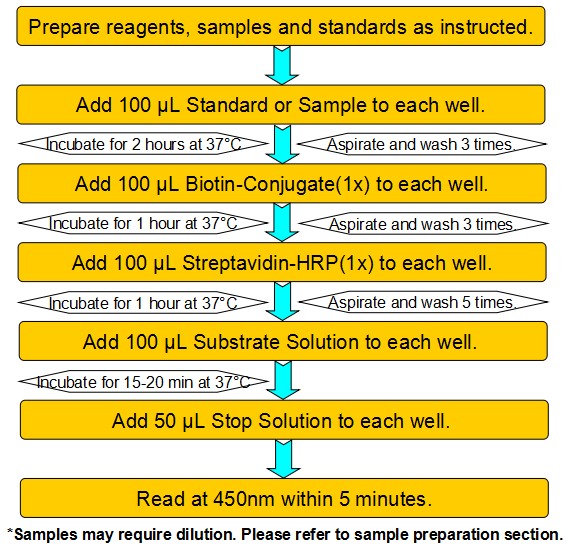Product Details
| 种属 |
Cat (Felis catus,Feline) |
| UniProt号 |
N/A |
| 缩写 |
CTX-I |
| 别名 |
N/A |
| 线性范围 |
0.156-10 ng/mL |
| 灵敏度 |
0.078 ng/mL |
| 样本类型 |
Serum, Plasma, Other biological fluids |
| 检测方法 |
Sandwich |
| 分析方法 |
Quantitive |
| 反应时间 |
1-4.5h |
| 样本体积 |
1-200 μL |
| 检测波长 |
450 nm |
原理
This assay employs a two-site sandwich ELISA to quantitate CTX-I in samples. An antibody specific for CTX-I has been pre-coated onto a microplate. Standards and samples are pipetted into the wells and any CTX-I present is bound by the immobilized antibody. After removing any unbound substances, a biotin-conjugated antibody specific for CTX-I is added to the wells. After washing, Streptavidin conjugated Horseradish Peroxidase (HRP) is added to the wells. Following a wash to remove any unbound avidin-enzyme reagent, a substrate solution is added to the wells and color develops in proportion to the amount of CTX-I bound in the initial step. The color development is stopped and the intensity of the color is measured.
产品概述
The carboxyterminal telopeptide of type I collagen (ICTP) is an indicator of degradation of type I collagen. ICTP antigen consists of a trivalent collagen cross-link joining three polypeptide chains of which two are α1 chains of one collagen molecule while the third is derived from either an α1 or an α2 chain of the helical region of another molecule (Fig. 1) (Risteli et al. 1993). The major determinant for antigeneity must contain two phenylalanine-rich regions, which is only possible if the cross-link is trivalent in nature (Sassi et al. 2000). In osteoclasts, catepsin K cleaves the trivalently cross-linked ICTP structure at two sites between the phenylalanine-rich region and the cross-link, thereby destroying any reactivity with ICTP antibodies (Sassi et al. 2000). Therefore degradation of type I collagen in bone is not measurable by the present ICTP-test. ICTP is cleared from circulation by the kidneys and has a molecular mass of about 12 000-20 000 (Risteli et al. 1993).
组份
Reagents |
Quantity |
Reagents |
Quantity |
Assay plate (96 Wells) |
1 |
Instruction manual |
1 |
Standard (lyophilized) |
2 |
Sample Diluent |
1 x 20 mL |
Biotin-Conjugate (concentrate 100 x) |
1 x 120 μL |
Biotin-Conjugate Diluent |
1 x 12 mL |
Streptavidin-HRP (concentrate 100 x) |
1 x 120 μL |
Streptavidin-HRP Diluent |
1 x 12 mL |
Wash Buffer (concentrate 25 x) |
1 x 20 mL |
Substrate Solution |
1 x 10 mL |
Stop Solution |
1 x 6 mL |
Adhesive Films |
4 |
特异性
This assay has high sensitivity and excellent specificity for detection of Human CTX-I. No significant cross-reactivity or interference between Human CTX-I and analogues was observed.
回收率
Matrices listed below were spiked with certain level of recombinant Human CTX-I and the recovery rates were calculated by comparing the measured value to the expected amount of Human CTX-I in samples.
精密度
Intra-assay Precision (Precision within an assay) Three samples of known concentration were tested twenty times on one plate to assess intra-assay precision. Inter-assay Precision (Precision between assays) Three samples of known concentration were tested in forty separate assays to assess inter-assay precision. CV (%) = SD/meanX100 Intra-Assay: CV<8% Inter-Assay: CV<12%
线性
The linearity of the kit was assayed by testing samples spiked with appropriate concentration of Human CTX-I and their serial dilutions. The results were demonstrated by the percentage of calculated concentration to the expected.
稳定性
The stability of ELISA kit is determined by the loss rate of activity. The loss rate of this kit is less than 5% within the expiration date under appropriate storage condition. The loss rate was determined by accelerated thermal degradation test. Keep the kit at 37°C for 4 and 7 days, and compare O.D.values of the kit kept at 37°C with that of at recommended temperature. (referring from China Biological Products Standard, which was calculated by the Arrhenius equation. For ELISA kit, 4 days storage at 37°C can be considered as 6 months at 2 - 8°C, which means 7 days at 37°C equaling 12 months at 2 - 8°C).
样本收集及储存
Serum: Use a serum separator tube (SST) and allow samples to clot for two hours at room temperature or overnight at 2 - 8°C before centrifugation for 15 minutes at 1000 × g. Remove serum and assay immediately or aliquot and store samples at ≤ -20°C. Avoid repeated freeze-thaw cycles.
Plasma: Collect plasma using EDTA, or heparin as an anticoagulant. Centrifuge for 15 minutes at 1000 × g at 2 - 8°C within 30 minutes of collection. Assay immediately or aliquot and store samples at ≤ -20°C. Avoid repeated freeze-thaw cycles.
Other biological fluids: Centrifuge samples for 20 minutes at 1000 × g. Remove particulates and assay immediately or store samples in aliquot at -20°C or -80°C. Avoid repeated freeze/thaw cycles.
注意事项
Store at 2-8°C. Please refer to Instruction Manual.



